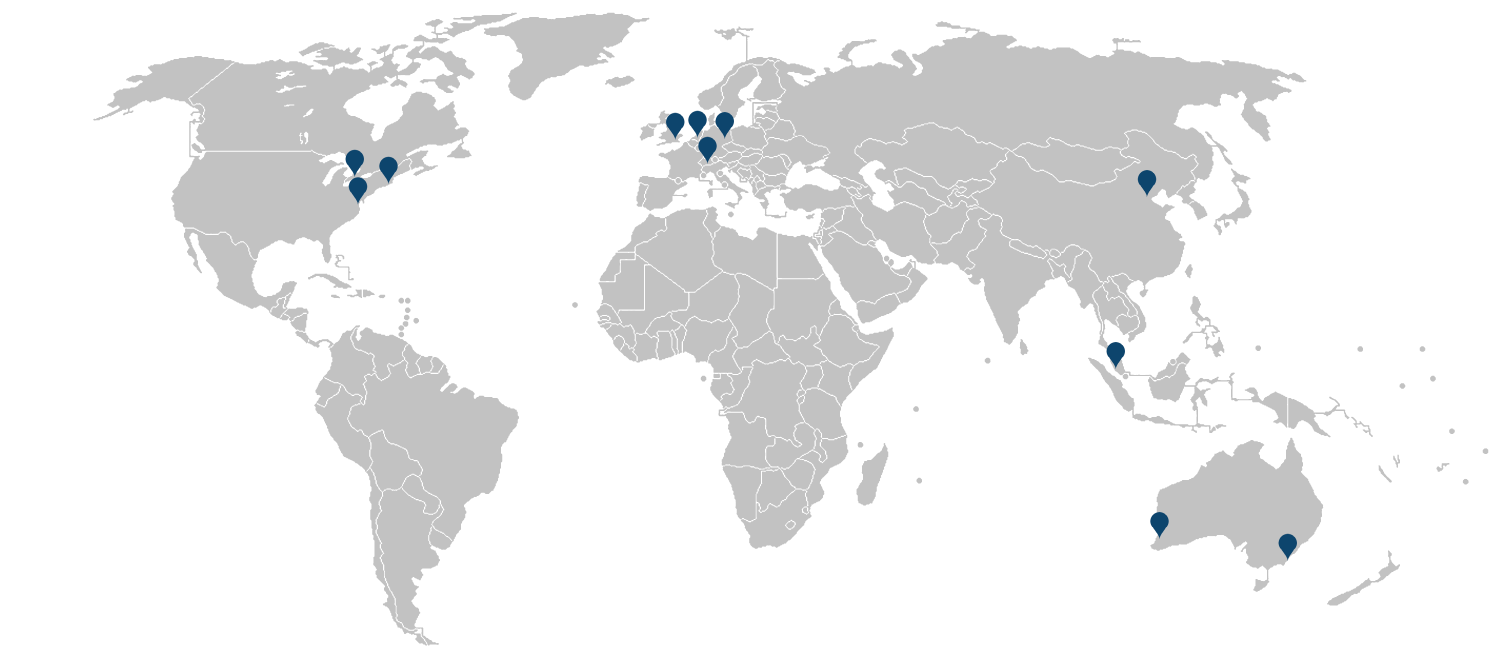Priority issues for research on central banks, supervision and greening the financial system
Priority issues for research on central banks, supervision and greening the financial system
In reflection of the high-quality research proposals received in March 2019, we released a second comprehensive call in July 2019. This call covered a broad range of key research questions linked to the NGFS’s work program: i) microprudential, ii) macrofinancial, iii) scaling up green finance, and iv) cross-cutting issues. We received 54 proposals and funded 10 projects carried out by 41 researchers affiliated with 20 institutions.
Researcher locations

Downloads
Funded projects:
Using credit risk as an empirical basis for the development of Brown taxonomies
Green taxonomies are designed to highlight investment opportunities for a transition to a low-carbon economy. While useful for many purposes, they fail to capture risks. Banking supervisors are now pressing for the development of dirty taxonomies as a way of quantifying potential stresses in the financial system associated with climate change.
Our project considers how integration of climate risk assessment and credit risk assessment can form a transparent and replicable methodology for accomplishing this goal. A useful dirty taxonomy should be able to identify assets and firms whose adaptive capacity limits their ability to navigate physical and transition risks. The analysis will be forward-looking and rely on scenarios. Perhaps most crucially, the outputs of the taxonomy should be clearly traceable to major input assumptions. In contrast to green taxonomies, one cannot say a priori what is dirty. Much depends on an unknowable set of policy interventions, technological developments, and localised events that will occur in the future.
To gain a transparent and replicable dirty taxonomy, we will proceed by organising asset- and firm-level impacts into three major categories: adaptation risks, mitigation risks, and natural capital risks. These risks will be analysed within an integrated assessment model that we have combined with a structural economic model. We adopt three transition scenarios that are examined across three time horizons. Testing our methodology on firms in the European energy sector, the outputs establish the materiality of risk factors. Tracing clearly from inputs to outputs allows for changes in credit quality to be observed for individual firms. The work will reveal whether events such as the weakening of coal producers and the utilities sector over the past decade are idiosyncratic, or representative of a ‘new normal’ under a transition to a low-carbon economy.
Show LessDo the UN SDGs affect sovereign bond spreads? Initial evidence
The traditional relationship between sovereign bond spreads and macroeconomic fundamentals appears to be weak since the financial crisis. In search of additional determinants, scholars shifted their attention toward intangible factors related to ESG dimensions. Country ESG ratings are used to measure a country’s sustainability level, but often solely provide information about a country’s policy toward these intangible factors. We believe that the SDGs can provide a better measure for sustainability of a country. The strength of the U.N. SDGs is that all goals are interlinked; governments are unable to cherry-pick their favourite goal. Unlike ESG ratings, the SDGs can be seen as a measure of the transition of the country toward full sustainability and are therefore output- and future-oriented. In addition, the SDGs are a direct measure of a government’s pledge to achieve social inclusion and environmental protection by 2030.
We use the dataset of the latest Sustainable Development Report, which includes an overview of countries’ performance on the SDGs to investigate the impact of SDG performance on sovereign bond spreads. We will use a broad range of low- and high-income countries to capture government bonds issued in different currencies. We are interested in the governments that are unprepared will increase the risk of unforeseen future SDG-related government expenses. An increase in government expenditures will negatively impact a government’s budget and its likelihood to repay its debt. Investors may demand to be compensated for this higher perceived country risk, influencing borrowing costs for governments.
Show LessSupervision beyond the business cycle: A framework for long-term financial supervision
Financial supervisory mandates are interpreted to ensure financial stability ‘over the business cycle’ (three to five years). New risks are challenging this paradigm, as they manifest themselves both over longer time horizons and as secular, one-directional shocks. We have designed this exploratory conceptual project to identify potential mechanisms and levers financial supervisors can mobilise in order to ‘supervise the long-term’ and reframe their mandate to cover more long-term risks.
Current financial policy and supervisory analysis falls into two categories. In the first category, financial policy analysis seeks to identify potential levers within the mandate to supervise risks over the business cycle (e.g., capital requirements) or support societal goals. The second category involves the development of tools to analyse the financial materiality of long-term risks (e.g., climate scenario analysis). Missing within this paradigm is the ‘adapter’ that allows for the integration of the second category of analysis into mainstream supervisory frameworks. As a result, stress tests looking out to 2030 are intellectually satisfying, but remain largely theoretical exercises.
We seek to begin to fill this gap by suggesting a framework for what long-term financial supervision could look like that would allow for the integration of these long-term risk assessments, as well as the steering of policy levers beyond business cycle risk management. This requires a review of both existing and potential new policy instruments, as well as more general questions over how such policy could work (including related to the arbitrage between short-term and long-term risks).
The primary output of our research will be a discussion paper focused on two central questions:
- What are the instruments to enhance the supervision of long-term risks?
- How might governance and mandates need to change to support the supervision of long-term risks?
Outputs
Working Group on Banking Supervision and Sustainable Development in the Americas
Banking regulations are known to have substantial leverage on the real economy for the simple reason that finance permeates everywhere. By the same token, they are a suitable instrument for improving the preparedness of the real economy for climate change. We convene a working group of prominent practitioners from among the collectivity of bank supervisors and regulators in the Americas, along with recognised experts in the field in order to review the state of practice regarding the incorporation of climate change into micro prudential regulatory frameworks.
For purposes of ordering the discussion, existing and potential practices will be grouped into four categories:
- Those where the authorities provide finance by instruction.
- Those where the authorities provide incentives for desired types of finance.
- Those where the authorities reduce financial risk by socialising potential losses by means of insurance, direct payments, or exceptional access to citizens’ own assets.
- Those where systems are set up to prevent, contain, and abate negative externalities.
To assist the working group’s deliberations, we will provide reference documents on existing practices, as well as on plausible modifications in existing regulations that can have important positive impacts for climate change and adaptation. The working group will also be asked to discuss the feasibility of specific innovations for making regulations more climate-friendly, and to review potential obstacles, barriers, and resistance to the implementation of such potential change. The document emerging from the working group’s deliberations will provide policy recommendations and, where appropriate, a further research agenda.
Working Group members:
- Evasio Asencio, Commissioner Owner, Comisión Nacional de Banca y Seguros, Honduras.
- Carolina Benavides-Piaggio, Senior Capacity Development Officer, FMO, The Netherlands.
- Keron Burrell, Head Methods, Analysis and Quality Review Department Bank of Jamaica.
- Ethel Deras, President Comisión Nacional de Banca y Seguros, Honduras.
- Rafael Del Villar Alrich, Advisor to the Governor Banco de México.
- Alan Elizondo, Director General, FIRA Mexico.
- Mariana Escobar, Head Sustainable Finance Group, Superfinanciera Colombia.
- Daniel Gomez Santeli, Risk Manager, Comisión Nacional de Banca y Seguros, Honduras.
- Kemar Hall, Assistant Director (Acting) Policy, Research, Methodology, and Development Department Bank of Jamaica.
- Patricia Moles, Advisor, Banco de México.
- Sheriffa Monroe, Director Policy, Research, Methodology, and Development Department Bank of Jamaica.
- Carlos Alberto Moya, Consultant
- Carmen Navarro, Senior Social and Environmental Officer, FMO, The Netherlands
- Ángel Odogherty Madrazo, Co-General Director Sector Intelligence, FIRA, Mexico
- Pascual O’Dogherty, Secretary-General, Association of Banking Supervisors of the Americas, Mexico
- Daniel Schydlowsky, Boston University Global Development Policy Center, USA
- Guilherme Teixeira, Manager Sustainable Finance, SITAWI Finanças do Bem, Brazil
Outputs
What are the options for sustainable crisis response measures?
We investigate response measures that could be deployed by central banks and other financial institutions in the context of the Covid-19 crisis in a way that contributes to sustainability. Originally conceived to develop a framework for policy responses for the next financial crisis, the project concept was updated to consider policy options for both the stabilisation and the recovery phases of the current crisis. We review and assess existing and novel proposals and present a menu of post-crisis management tools for central bankers, financial regulators, and governments, with an evaluation of their sustainability-related risks and benefits, taking particular note of the environmental and social equity dimensions. The project will consider the suitability of different response options in Europe, Asia, and North America based on available knowledge about tools used in prior crises and in this crisis so far. Policy options for different areas will be discussed in a series of closed and public webinars, and policy recommendations will be published in a policy brief series that will form the basis of an overall summary report.
Show LessAdjusting sovereign credit ratings to reflect climate change
Financial markets face increasing pressure to factor climate risks into decision-making. Enthusiasm for ‘greening the financial system’ is welcome, but a fundamental challenge remains: Investors lack the necessary information. This creates a potential conflict of interest and information asymmetry: Sovereigns want cheap access to capital and have an incentive to downplay climate risk, while investors want to manage climate exposure but do not know how much risk they face. Without a standardised framework and regulatory requirement for disclosing climate risk, organisations face little incentive to provide such information accurately to investors.
Existing climate risk disclosures are rare, ad hoc, voluntary, unregulated, and generally based on internal assessments rather than climate science. Credit ratings agencies are key intermediaries between investors and investment opportunities, serving an important role by rating the creditworthiness of potential investments. They use established and published methods to combine publicly available information with an ‘inside look’ to measure the ability of the issuer to repay its debt obligations. Ultimately, their role is to help reduce information asymmetries, overcome conflicts of interest, and provide investors with standardised information about risk.
We examine how well ratings agencies capture climate risks in ratings. We investigate how well the financial system factors in climate-related risk and makes such information available to investors. First, using historical evidence, we determine whether past ratings have factored in observed climate-related losses. Next, we combine forward-looking climate models with the ratings methodology from a major credit ratings agencies to compare sovereign creditworthiness in a world with climate change, versus a counterfactual world without warming (in which temperatures are held constant at their 1980-2010 average). Finally, we mobilise our extensive network in finance, climate science, and economics to develop a provocative position piece on the state of green finance and future priorities.
Show LessOutputs
Management of Climate Risks in the Financial Industry of a Resource Based Economy: A Canadian Scenario Analysis
Although some studies exist on how the financial industry is affected by climate risks and how it might manage them, no such studies exist for a country with an economy that is mainly based on carbon-intensive resources, such as oil, gas, and mining. We conduct a scenario analysis based on an impact matrix that uses both physical and transition risks to model impacts on the financial portfolio of Canadian chartered banks. We will complement findings about climate-related risks and opportunities in Europe, Asia, and Africa that are different from climate change-related risks to North America and that are in countries with different regulatory frameworks.
Our research will be based on a formative scenario analysis and an impact matrix will be created based on the Intergovernmental Panel on Climate Change climate scenarios and climate scenarios for Canada. Based on different data sources, we will conduct a MICMAC analysis (a system of multiplication of matrices applied to the impact matrix) to calculate both direct and indirect impacts on Canadian banks’ financial risks. The expected results will help policymakers in countries with carbon-intensive economies to create financial policies, regulations, and supervision regimes that could be applied by central banks and other financial regulators to mitigate climate risk for the financial industry without creating otherwise significant negative impacts for these countries’ economies.
The results of this INSPIRE research will help banks to implement strategies to reduce their exposure to climate-related financial risks. Consequently, negative impacts on the Canadian financial industry could be avoided. This is important given that the Canadian banking sector is dominated by five chartered banks that are similar with regard to their businesses.
Show LessClimate Risk and Central Bank Refinancing Operations
We analyse the impact of central bank refinancing operations on bank lending, investment in the real economy, and financial stability. In particular, we assess whether and how much climate risk-adjusted refinancing operations that apply differentiated interest rates based on the climate risk exposures of bank loans would improve financial market outcomes in terms of lower-carbon investment.
We base our analysis in the context of a financial market failure, where firms and banks underestimate climate risks. For that, we use a model where underestimating climate risks on the side of firms causes under-investment into climate risk mitigation (CRM), and underestimating climate risks on the side of banks induces excessive lending to firms exposed to climate risk. Misallocation of resources in the real economy and bank defaults induce a welfare loss in the economy. Banks’ lending decisions can be steered through climate risk-adjusted refinancing operations by the central bank, which, in turn, reduce the misallocation of resources in the real economy. This outcome is reinforced by a subsidy to companies for CRM. Specifically, the interest rate policy adopted by the central bank is such that banks’ cost of refinancing depends on the allocation of loans to more and less risky firms. This way the central bank can correct the belief-distorted lending decisions. The socially optimal allocation is achieved by a combination of subsidies and targeted refinancing operations, i.e., fiscal and monetary policy are complementary.
Show LessDoes the green property reduce bank loan risk?
To address whether credit risk is lower for banks’ green assets, we perform a granular analysis on the risk implications of the green property of bank loans in the context of a comprehensive international bank loan dataset, Thomson Reuters’ DealScan. We address three key research questions related to the discussion of the adoption of a ‘green supporting factor’:
- Is the risk of banks’ green loans lower globally?
- If the risk is lower, what are the possible channels/mechanisms through which the green property exerts this effect?
- How can the green impact be calibrated into the green supporting factor and how can the empirical effect of the green supporting factor on banking systemic risk be quantified at the country level?
We conduct an empirical analysis, utilising the detailed global loan-level data from the LoanConnector database. Based on the empirical findings, we compose a single-period model to analyse the impact of a ‘green supporting factor’ (GSF) on bank risk profiles. We use the calibration to address our third research question and to gauge the extent to which a GSF changes bank loan risk at the end of the period where the equilibrium is reached. The calibration results quantify the impact of a GSF on bank loan risk profiles and the stability of financial markets as a whole.
Our expected findings will provide a systematic understanding of the linkage between green loans and their associated risk, which will help policymakers to quantify a green supporting factor and to understand the sensitivity of this factor to varying lender and borrower characteristics.
Show LessEstimating the impact of physical climate risks on the probability of default (PD) of mortgage loans in the coastal cities of China
Climate-related physical risks, such as typhoons, floods, and heat waves, will result in considerable damages and losses to the real economy and to the financial sector that provides financing for economic activities. Against this backdrop, the international financial community has been calling for attention and actions to integrate climate-related physical risks into financial decision-making by financial institutions. To manage environmental and climate risks, the primary step is to quantify these risks. However, literature that quantifies the implication of climate-related physical risks for the financial sector is very limited.
We present an analytical framework for measuring the impact of climate-related physical risks on the default risk of bank loans. We applied this method to quantify the increase in the probability of default of mortgage loans for properties in China’s coastal cities, caused by the increased intensity and frequency of typhoons under four commonly used climate scenario defined by the Intergovernmental Panel on Climate Change.
The preliminary findings of this INSPIRE study show that future typhoon events exacerbated by climate change along the coast of China could potentially lead to a considerable increase in the probability of default for mortgage loans, with a possible accumulation of incremental probability of default of more than 5%. This analytical framework can also be applied to many other scenarios of environmental and climate risk analysis for banks if the data required are available, such as impacts of floods and water shortages on credit risk of loans to sectors that are sensitive to such risks.
Show LessThe Optimal Mix of Monetary and Climate Policy
This research theoretically investigates the mix of monetary and climate policy and provides insights for central banks that are considering their engagement in the climate change issue. The “climate-augmented” monetary policy is pioneeringly proposed and studied.
Our research method is an extended Environmental Dynamic Stochastic General Equilibrium (E-DSGE) model. The basic DSGE setting is in line with the standard New Keynesian framework. The “Environmental” features are introduced by incorporating the greenhouse gas emissions from production, their negative externality on productivity, and the climate policy that controls emissions, i.e., cap-and-trade or carbon tax.
Based on the model, we preliminarily find the following results:
- The process of developing monetary policy should consider the existing climate policy since it is a factor that can influence price level and inflation.
- The reaction coefficients in traditional monetary policy rule can be better set to enhance welfare when climate policy is given. This provides a way to optimise the policy mix.
- If a typical-form climate target is augmented into the monetary policy rule, a dilemma could be created. This means that it has some risks for central banks to care for the climate proactively by using the narrow monetary policy (interest rate).





































